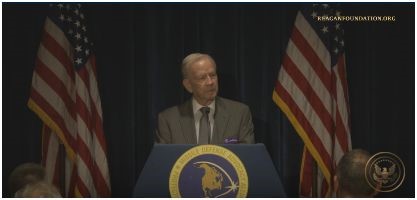|
Dear Members and Friends,
Last night, in partnership with the Ronald Reagan Presidential Foundation & Library and with the approval of the late Mrs. Nancy Reagan, MDAA was honored to host and commemorate the 33rd Anniversary of President Ronald Reagan’s Historic Strategic Defense Initiative Speech delivered on March 23, 1983. The full event can be watched below. We had the honor to bring a group of very distinguished speakers to discuss this historic milestone in U.S. defense policy. Those speakers included Mr. Robert C. “Bud” McFarlane, Former National Security Advisor under President Reagan from 1983-1985, Lieutenant General (Ret.) Henry A. “Trey” Obering III, Former Director of the Missile Defense Agency from 2004-2008, and Lieutenant General Samuel A. Greaves, the current Commander of Space and Missile Systems Center, Air Force Space Command. All of us that were there and on the live feed from the Reagan Library were very privileged to listen to the most articulate and credible account of the origins and purpose of SDI ever documented from an individual who worked should-to-shoulder with President Reagan, former National Security Advisor Bud McFarlene. Mr. McFarlene aptly described SDI as “one of the most historic moments in peace-making in modern history.”  Former National Security Advisor Bud McFarlene speaking at commemoration
“SDI was the keystone of a broader strategy that President Reagan had the vision to conceive of and carry out which ultimately ended the Cold War, brought down Marxism, and enabled the reduction of nuclear weapons for the first time in history. A pillar of that phenomenal historic vision, surely was the SDI.” Mr. McFarlene described the important role of foresight and strategic thought that played into President Reagan’s decision to pursue BMD capabilities to protect the United States and its allies. The President recognized the problems with depending solely on deterrence and Mutually Assured Destruction (MAD). “President Reagan was familiar with the arcane position that posited that peace could be maintained if both countries were vulnerable to a [nuclear] attack. To president Reagan, that was an intolerable basis for keeping the peace. He understood very well that, by the time he came into office, the Soviet Union outnumbered the U.S. by about 3:1 in warheads and missiles, and could plausibly carry out a first strike and disable all of the American land based missiles.” Mr. McFarlene discussed the number of ways the United States attempted to ensure the survivability of its missile forces to maintain MAD. However, it soon became evident to the President that there was no easy solution to ensuring a survivable missile force in the face of the overwhelming Soviet threat. “President Reagan gathered the Joint Chiefs and said ‘gentlemen, we haven’t been able to come up with a survivable offensive force, why don’t we try defense?’ Fortunately, one of the members of the Joint Chiefs, Admiral Jim Watkins, piped up and said ‘Mr. President, wouldn’t it be better if we could protect Americans rather than avenge them?’ That phrase really stuck in the President’s mind, so he directed in January of ’83, an R&D program to begin work toward the day when we would have an effective missile defense.” Mr. McFarlane addressed the critics that President Reagan faced as he pursued his plan of developing missile defense: “SDI was a giant example of political courage. Regardless of what you think, and the President thought [MAD] was immoral, but people argued that it’s worked, we haven’t been attacked. Somehow over 35 years, we have had this MAD apocalyptic strategy and it has sort of worked. The President said rubbish, it’s immoral to maintain the peace by attempting to destroy human kind. And so he turned around American strategic deterrence policy 180 degrees.” Following this emotional and inspirational history of the Strategic Defense Initiative presented by Mr. McFarlene, the distinguished speakers of LTG (Ret.) Trey Obering and LTG Sam Greaves put forth the growth of SDI into the current state of U.S. missile defense and its future direction. At the end of the presentations, MDAA with LTG Sam Greaves recognized the outstanding excellence of leadership in missile defense from our nation’s current soldiers from the 100th Missile Defense Brigade and airmen from the United States Air Force working on Missile Defense Systems of the Ground Based Missile Defense System out of Vandenberg Air Force Base in California and the Space Tracking and Surveillance System (STSS) out of Los Angeles Air Force Base:
We closed this historic ceremony by presenting models of the current Ground Based Interceptor and its Exoatmospheric Kill Vehicle-that are protecting our nation and over 300 million people today-to the Ronald Reagan Library to be displayed for the American Public. God Bless President Ronald Reagan and Mrs. Nancy Reagan. |
